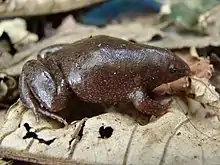| Myersiella | |
|---|---|
 | |
| Scientific classification | |
| Domain: | Eukaryota |
| Kingdom: | Animalia |
| Phylum: | Chordata |
| Class: | Amphibia |
| Order: | Anura |
| Family: | Microhylidae |
| Subfamily: | Gastrophryninae |
| Genus: | Myersiella A. L. Carvalho, 1954[2] |
| Species: | M. microps |
| Binomial name | |
| Myersiella microps | |
| Synonyms[3] | |
| |
Myersiella is a genus of frogs in the family Microhylidae. It is monotypic, being represented by the single species, Myersiella microps.[4] It is endemic to southeastern Brazil and occurs in Espírito Santo, Rio de Janeiro, southeastern Minas Gerais, and southeastern São Paulo state.[1][3][5] The genus name honors George S. Myers.[2] The genus is sometimes known as the elongated frogs,[4] while the sole species is known as Rio elongated frog.[3]
Taxonomy
Myersiella was originally defined based on skeletal morphology.[2] Later studies based on molecular data have supported its recognition as a monophyletic group,[4][6] with Dasypops as its sister taxon.[6]
Description
Adult males measure 20–25 mm (0.8–1.0 in) and adult females 25–46 mm (1.0–1.8 in) in snout–vent length. The head is very small but with a prominent, pointed snout. No tympanum is visible. The eyes are very small. The limbs are short and stout; the fingers and toes are cylindrical and have no webbing. Coloration is relatively uniform dark lead grey with very light brown ventral flecking. Males have blackened throats.[7]
The male advertisement call is a long frequency-modulated note dominated by frequences between 2.4 and 2.6 kHz.[8] Myersiella microps has direct development[1][6] (i.e., there is no free-living larval stage[9]).
Habitat and ecology
Myersiella microps occur in primary and secondary forest at elevations below 1,100 m (3,600 ft). They live in the leaf litter on the forest floor[1] and under fallen tree trunks and rocks.[5] Males have been observed calling on the forest floor during rains.[8] The larvae develop in the eggs in the leaf litter.[1] Their diet consists of ants.[7]
Conservation
Myersiella microps is a very common species, but it is difficult to find. This species does not occur in open areas and can be threatened by loss of its forest habitat. However, it does occur in several protected areas.[1]
References
- 1 2 3 4 5 6 Sergio Potsch de Carvalho-e-Silva, Vanessa Verdade (2010). "Myersiella microps". IUCN Red List of Threatened Species. 2010: e.T57898A11690346. doi:10.2305/IUCN.UK.2010-2.RLTS.T57898A11690346.en. Retrieved 17 November 2021.
- 1 2 3 Carvalho, Antenor Leitão de (1954). "A preliminary synopsis of the genera of American microhylid frogs". Occasional Papers of the Museum of Zoology, University of Michigan. 555: 1–19. hdl:2027.42/56993.
- 1 2 3 Frost, Darrel R. (2021). "Myersiella microps (Duméril and Bibron, 1841)". Amphibian Species of the World: An Online Reference. Version 6.1. American Museum of Natural History. doi:10.5531/db.vz.0001. Retrieved 18 April 2021.
- 1 2 3 Frost, Darrel R. (2021). "Myersiella Carvalho, 1954". Amphibian Species of the World: An Online Reference. Version 6.1. American Museum of Natural History. doi:10.5531/db.vz.0001. Retrieved 18 April 2021.
- 1 2 Peixoto, Marco Antônio de Amorim; Lacerda, João Victor Andrade; Guimarães, Carla Da Silva; Teixeira, Bruno; Da Silva, Emanuel Teixeira & Feio, Renato Neves (2013). "Amphibia, Anura, Microhylidae, Myersiella microps (Duméril and Bibron, 1841): new records and geographic distribution map". Check List. 9 (4): 847–848. doi:10.15560/9.4.847.
- 1 2 3 De Sá, R. O.; Streicher, J. W.; Sekonyela, R.; Forlani, M. C.; Loader, S. P.; Greenbaum, E.; Richards, S. & Haddad, C. F. B. (2012). "Molecular phylogeny of microhylid frogs (Anura: Microhylidae) with emphasis on relationships among New World genera". BMC Evolutionary Biology. 12: 241. doi:10.1186/1471-2148-12-241. PMC 3561245. PMID 23228209.
- 1 2 Nelson, Craig E. & Lescure, Jean (1975). "The taxonomy and distribution of Myersiella and Synapturanus (Anura: Microhylidae)". Herpetologica. 31 (4): 389–39 7. JSTOR 3891525.
- 1 2 Hartmann, Marília T.; Hartmann, Paulo A. & Haddad, Célio F. B. (2002). "Advertisement calls of Chiasmocleis carvalhoi, Chiasmocleis mehelyi, and Myersiella microps (Microhylidae)". Journal of Herpetology. 36 (3): 509–511. doi:10.2307/1566200. JSTOR 1566200.
- ↑ Vitt, Laurie J. & Caldwell, Janalee P. (2014). Herpetology: An Introductory Biology of Amphibians and Reptiles (4th ed.). Academic Press. p. 166.
